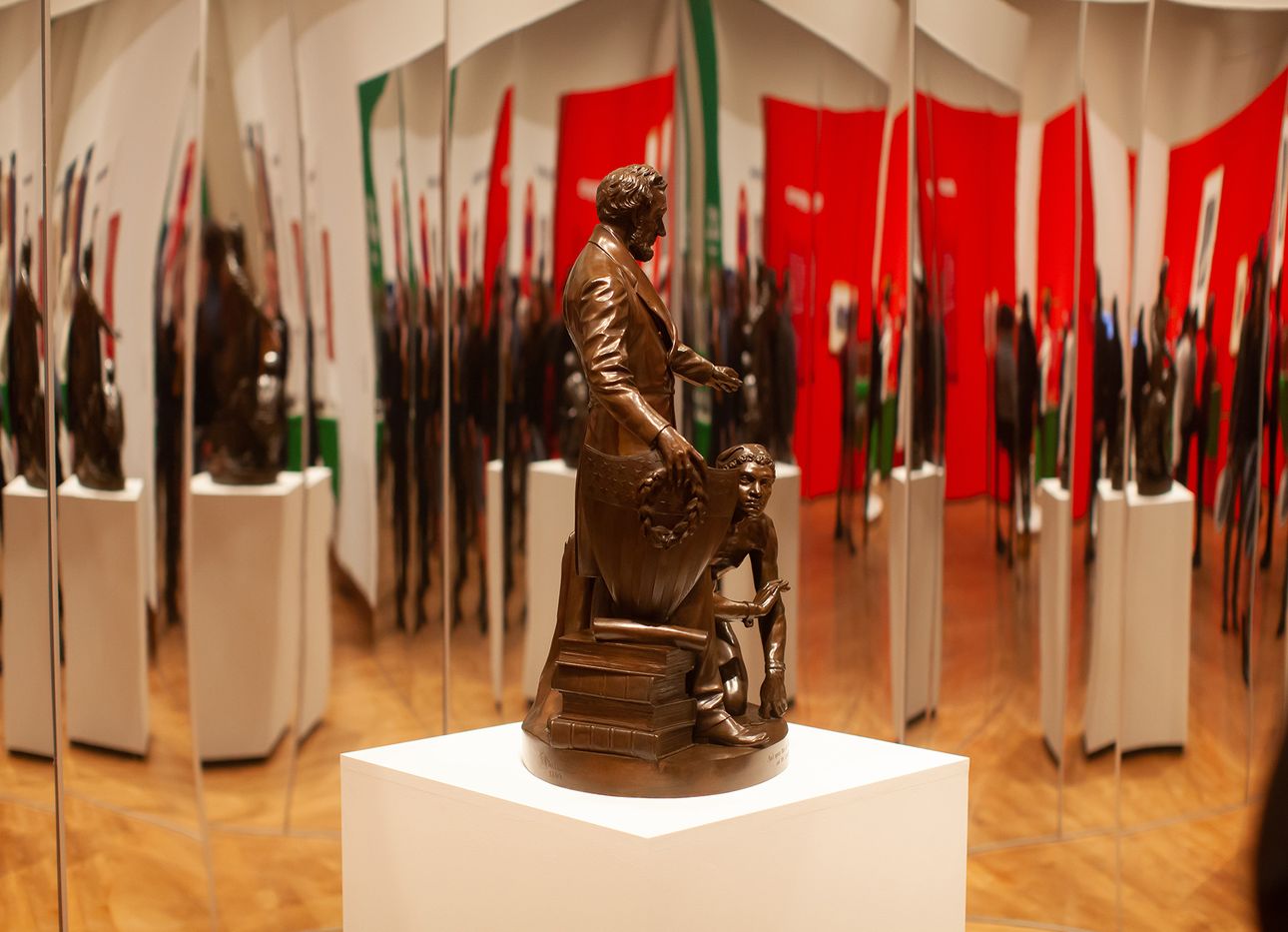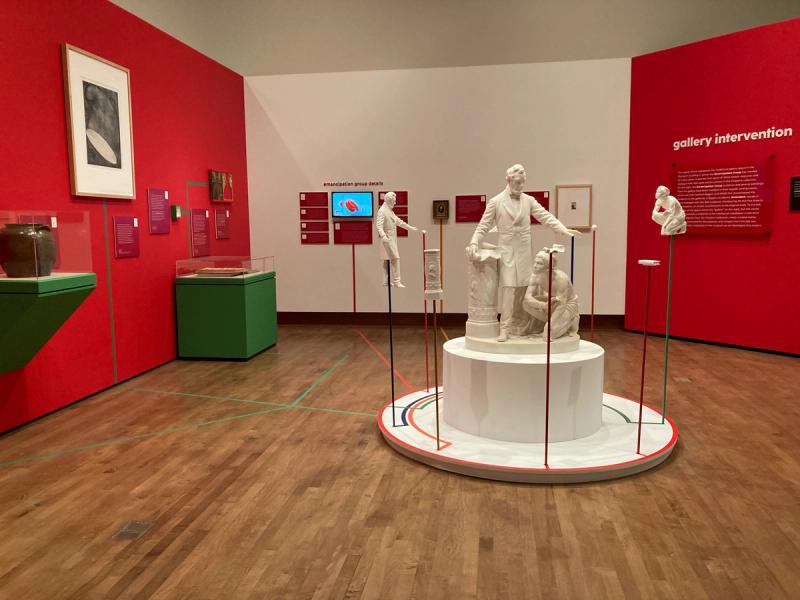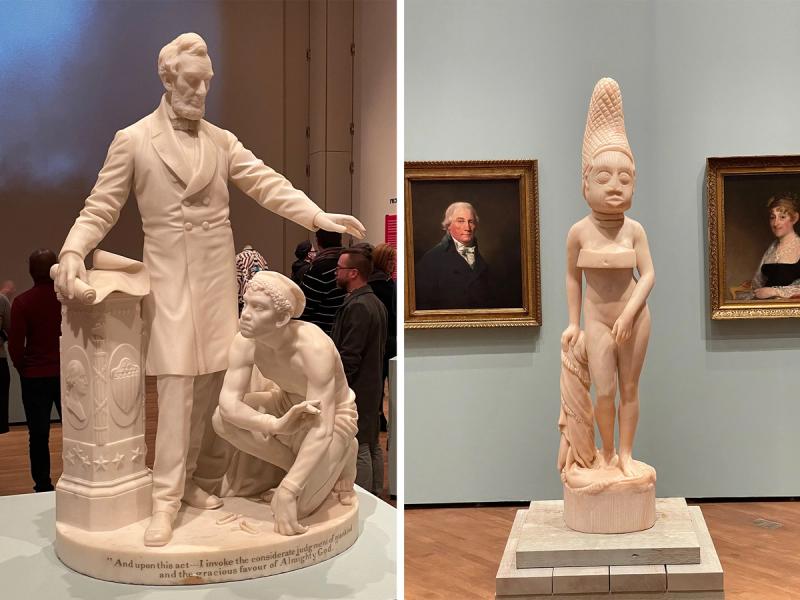
Sanford Biggers, a Collective of Artists, and a Museum Interrogate a Problematic Abraham Lincoln Monument
Nearly 150 years ago, on April 14, 1876—the eleventh anniversary of Abraham Lincoln’s death—Frederick Douglass spoke before a gathered crowd in Washington, D.C.’s Lincoln Park for the dedication of a new monument. Sculpted by Thomas Ball, the statue, known as the “Emancipation Memorial,” depicts an expertly tailored Lincoln holding a copy of his Emancipation Proclamation as a muscular and barely clothed freedman kneels beneath him. “Friends and fellow citizens,” Douglass said, “I warmly congratulate you upon the highly interesting object which has caused you to assemble in such numbers and spirit as you have today.”
Now, this “highly interesting”—and, in the context of today’s reckoning around racial justice, highly problematic—statue is the focus of a deeply researched and expertly arranged exhibition, “re:mancipation,” on view through June 25 at the University of Wisconsin-Madison’s Chazen Museum of Art. Organized by the Harlem-based artist Sanford Biggers (the guest on Ep. 66 of our At a Distance podcast), a coalition of artists and cultural institutions called the MASK Consortium, and the Chazen, the presentation brings together three copies of the Ball statue—one of them from the Chazen’s permanent collection, the others on loan from Colby College and Washington University in St. Louis—and interrogates its various iconographic details and meanings. Rather than showcase any one clear-cut historical narrative, “re:mancipation” reveals a plurality of perspectives and interpretations. Embracing Biggers’s ongoing efforts to “re-right” history, the show is a physical embodiment of the scholar Saidiya Hartman’s notion of “temporal engagement”: The Ball statue may have been created in the distant past, but it’s very much active in and entangled with the present.
At a time in which Confederate, imperialist, and colonialist monuments and memorials continue to be removed and torn down worldwide, and in which museums face increased scrutiny—from who their board members are, to their ethical implications in presenting looted artifacts, to their diversity, equity, and inclusion policies—“re:mancipation” joins a flurry of necessary and urgent reconciliation efforts, including the exhibition “Emancipation: The Unfinished Project of Liberation” at the Amon Carter Museum of American Art in Fort Worth, Texas (through July 9)—which showcases, in similar fashion, artist responses to John Quincy Adams Ward’s bronze sculpture “The Freedman” (1863)—and the Mellon Foundation’s $250 million Monuments Project, launched in 2020 and shepherded by the organization’s executive director, Elizabeth Alexander (the guest on Ep. 52 of our Time Sensitive podcast). Also to rise up in the past decade is the 11-year-old Philadelphia nonprofit Monument Lab, which in 2020 received a catalytic $4 million Mellon Foundation grant and has become a key research hub for issues of memorialization. (“re:mancipation” is also supported with funding from the Mellon Foundation.)

For both Biggers and Amy Gilman, the director of the Chazen, “re:mancipation” is part of a much larger constellation of conversations about monuments and memorials—and connected to that, about coming to terms with systemic racism and white supremacy in the United States. “The exhibition is not the point,” Gilman says. “The exhibition is a point. That’s a really important part of this project, is that it’s so generative.”
Viewing “re:mancipation” as an “incubator” and a “blueprint” for other institutions and museums to consider or follow, Biggers emphasizes that the show is but one stepping stone in what remains an ongoing, centuries-long march forward for racial justice. “This is not a new conversation,” he says, adding, “We have to recognize that for all of our claims of being a democracy and being able to talk and hash things out, if we’re still having the same conversation about these things a couple hundred years in, we haven’t been doing too well with that conversation.”
Noting the inherent tension between the physical longevity of a monument and the ephemerality of time, Bigger says, “I’ve often said, for better or for worse, that history is malleable. History is not, no pun intended, set in stone.” “re:mancipation,” by extension, seeks to make conversations about racial justice literally more concrete by focusing on a single statue, and by inviting a chorus of voices to respond to that one object.
The project began in 2019, when a solo exhibition of Biggers’s work, “BAM!,” opened at the Chazen. It was while working on that show that Biggers and MASK’s Mark Hines first saw the museum’s white marble “Emancipation Group” statue, the model on which Ball’s “Emancipation Memorial” bronze was later based. “I knew about the sculpture in general, from history, maybe from a glance while passing in a car in D.C.,” Biggers says. Seeing the copy at the Chazen piqued his curiosity. “I immediately gravitated toward the symbols: the shackles, the heart, pedestal, the book, the banner.”
Conversations about “Emancipation Group” with Gilman and members of the MASK Consortium exploded from there. Then, the pandemic arrived. George Floyd’s murder and the swell of Black Lives Matter protests across the country followed, which then grew into an international movement. Recalls Biggers: “When the conversation about this sculpture came back up, we were like, ‘We already have such a fertile conversation. Why not put the onus on the school to deal with it responsibly and make the conversation happen?’”
Gilman stepped up and embraced the project full-on. Framing the exhibition less as an art history lesson—although traditional iconographic analysis is central to the show—Gilman saw it more so as a conversation-multiplier. “It’s a vehicle, it’s a doorway, it’s a portal,” she says. “The exhibition’s not just about this object. There are lots of objects we could have chosen. What I hope is that this becomes a way of working.”
Inside the exhibition, a tightly packed entryway presents a historical timeline—from 2500 B.C., to early human life on the African continent, to the founding of the United States, to the Civil War—through a series of objects from the Chazen’s collection, including a 19th-century Shiva bronze from India, Dogon and Edo masks from Mali and Nigeria respectively, and an 1890 bronze depicting the Continental Army soldier Nathan Hale. Just beyond the Civil War wall descriptors, the presentation opens up—explodes, even—into a rich, artfully displayed examination of the “Emancipation Group.” Sprinkled throughout are works that connect, in fascinating and roundabout ways, to the original Ball statue, whether it be a circa 1855 jar by the potter David Drake or “Phrygian,” a 2012 etching by Martin Puryear. A sculpture by Biggers, “The Ascendant” (2020), depicting a female figure that combines the body of Hiram Powers’s “The Greek Slave” (1846) with the head of a Benin queen mother, stands near the middle of the space, as a counterpoise and counterpoint to the show’s centerpiece: the Chazen’s marble “Emancipation Group” model. Also powerfully contrasted, on opposite walls in the main space, are George Hayter’s 1831 “Portrait of Lady Caroline Montagu,” of the daughter of the fifth Duke of Manchester as she casually leans against a trunk full of trinkets and loot, with a distaff (a tool used in spinning) and pistol at her side, and Kehinde Wiley’s 2017 “Portrait of Carrie Mae Weems” from his “Tricksters” series of powerfully poised portraits of groundbreaking Black artists.

Throughout, traditional notions of how an artwork or piece of history should be presented is questioned. For Biggers, the fact that the Chazen is part of a public university—an institution within yet another institution—made the project all the more compelling. Beyond the exhibition, “re:mancipation” is a multiyear interdisciplinary research exercise, with teaching tools and formal curricula to come out of it. The effort is also one of artistic dialogue, with MASK inviting the rapper Pharoahe Monch, artist and designer Wildcat Ebony Brown, and jazz trumpeter Keyon Harrold, among others, to create their own works in response to “Emancipation Group.” “Chop the head off of false idols/Topple the statues, set them ablaze/T. Donald make Ronald Reagan turn in his grave/Season discrimination, sprinkle a little sage/Add a dash of hatred, eat it and get on stage,” begin the lyrics to “Cult 45,” Monch’s response piece.

At the exhibition’s opening night—before performing his song “Still Standing,” about his struggles with asthma—Monch greeted the gathered crowd, saying, “When I was invited to give my opinion in response to the ‘Emancipation’ statue, I was taken aback by the fact that this [freedman] was still crouching, and it took me to words from Frederick Douglass, who wondered: If this is a monument commemorating the freedom of all men, why would the enslaved man still be crouching and not standing? It’s a struggle that we deal with still to this day. We’ve persevered through it, and I’m proud to say we are still here and we are still standing.” From Douglass to Monch, the conversation continues.